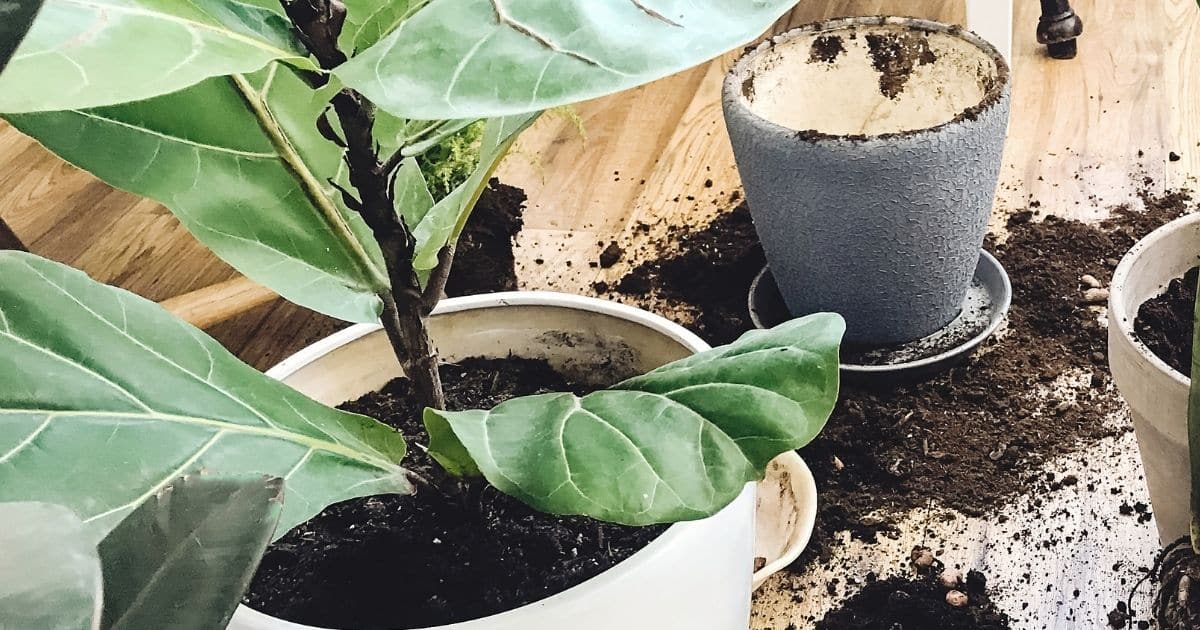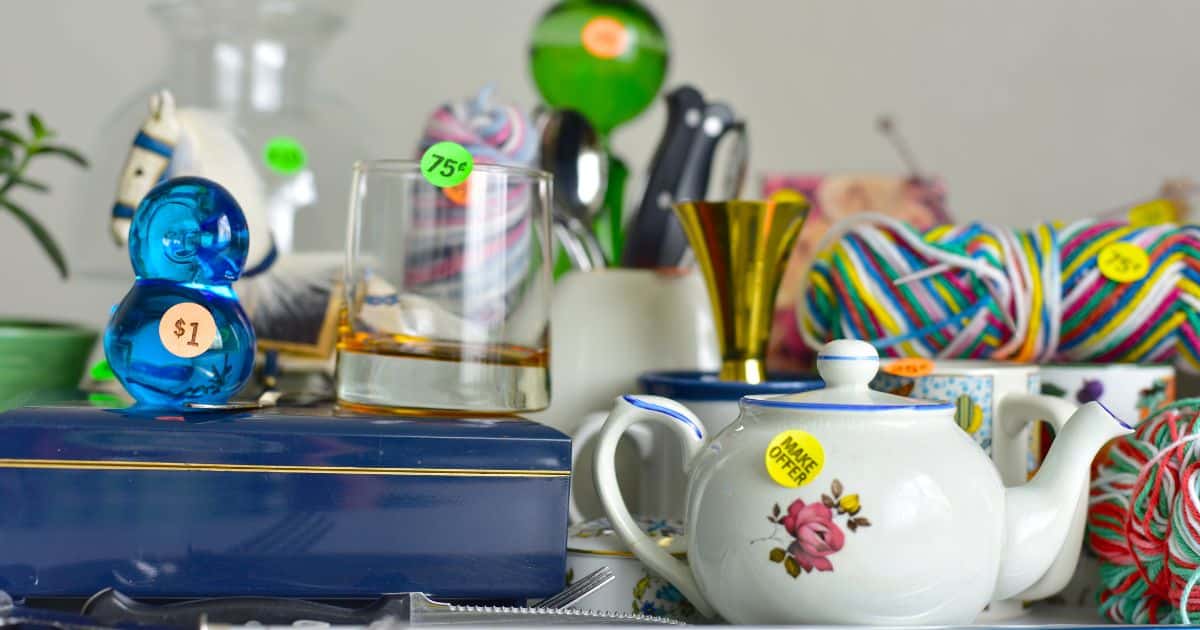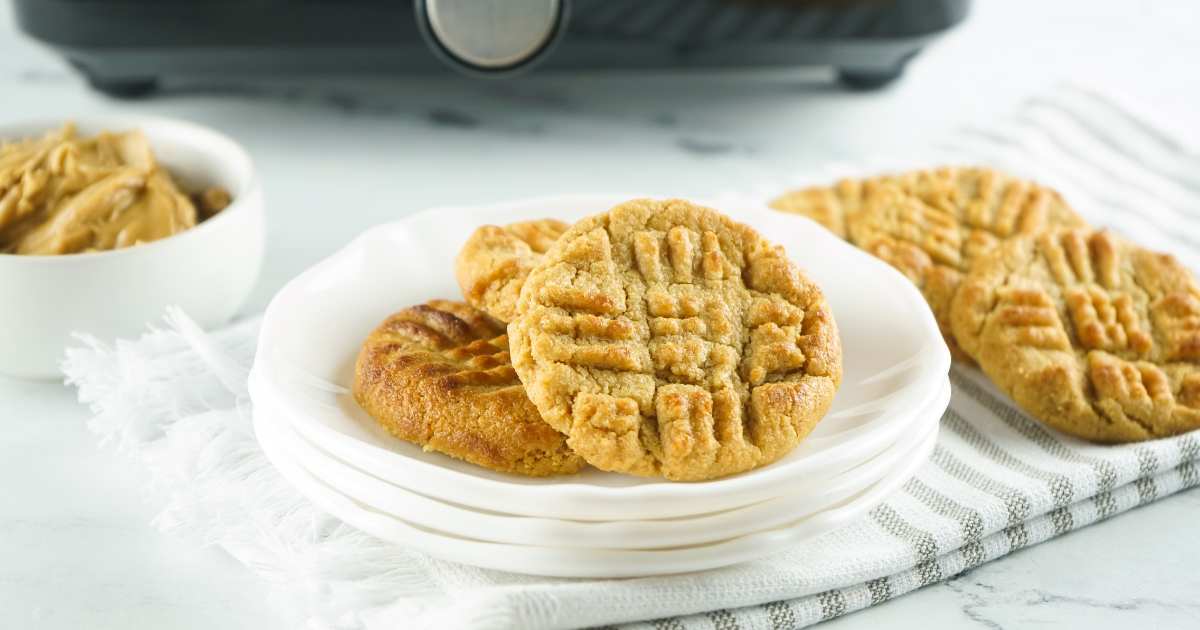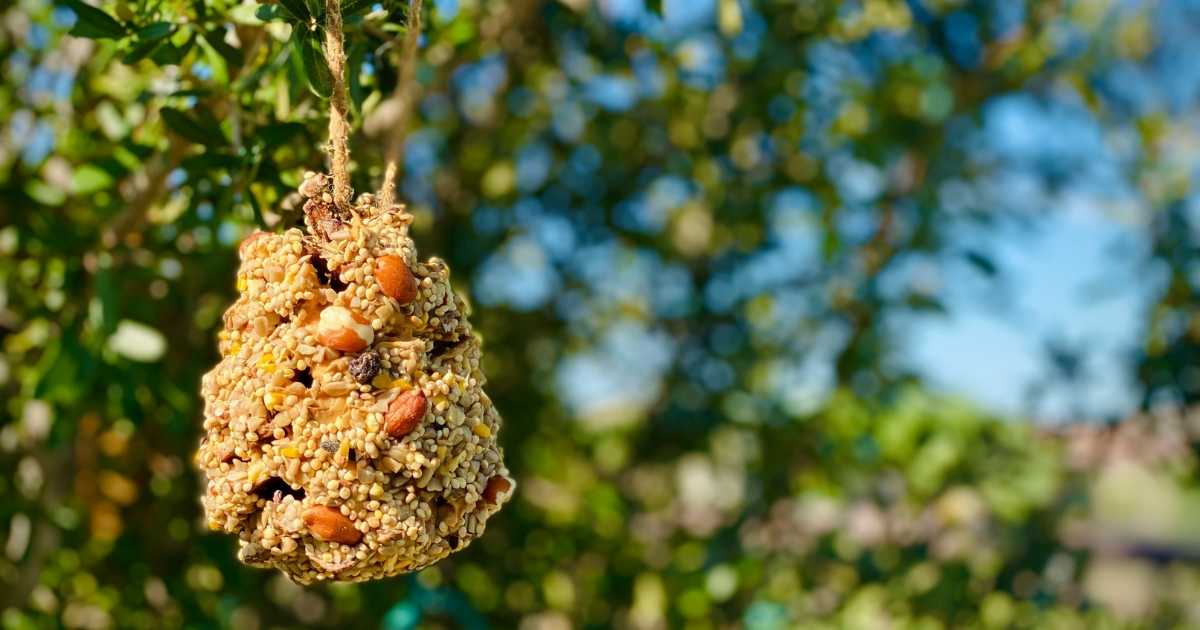How to Grow Basil in Arizona in 10 Easy Steps
Welcome to my blog article on how to grow basil in Arizona.
Basil is a popular herb widely used in cooking, medicine, and aromatherapy and can be a rewarding addition to your garden or indoor space.
However, growing basil in Arizona can be challenging due to the hot and dry climate.
In this article, I’m sharing valuable tips and techniques on growing basil successfully in Arizona that I’ve learned over the years, including the best time to plant, soil preparation, watering and fertilizing, pest and disease control, and much more.
Whether a beginner or an experienced gardener, this article will provide the knowledge and tools you need to grow healthy and productive basil plants in Arizona.
There’s nothing better than having fresh herbs in the garden! So let’s get started!
This post may contain affiliate links. Click to visit policies and disclosures
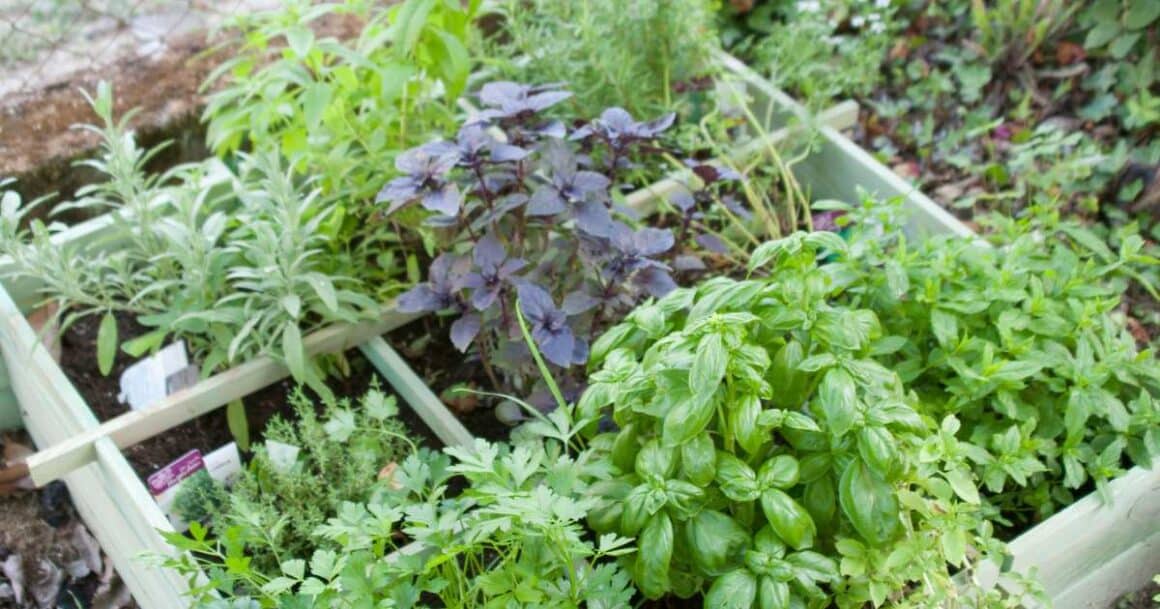
About Basil (ocimum basilicum)
Basil is an annual herb that is a popular herb that is commonly used in cooking.
Basil is a herbaceous plant that typically grows 12 to 24 inches, with a spread of 12 to 18 inches.
Its leaves are ovate or lance-shaped and are typically bright green, although some varieties may have a purple or dark green hue. When crushed, the leaves have a beautiful, fragrant aroma.
The stems of basil plants are usually green but may have a reddish tinge in some varieties. When basil plant flowers, they produce small white flowers that grow in spikes.
Basil is a versatile herb widely used in cooking, medicine, and aromatherapy.

Common uses for basil
Culinary
Basil is a popular herb in Italian and Mediterranean cuisine and is commonly used in dishes like pesto, Caprese salad, and tomato sauce.
It also pairs well with other herbs and spices, such as garlic, oregano, and thyme.
Medicinal herb
Basil has been used for centuries in traditional medicine and is known for its anti-inflammatory and antioxidant properties.
Its health benefits aid in digestive issues, respiratory problems, and skin conditions, among other ailments.
Aromatherapy
Basil essential oils are commonly used in aromatherapy for its calming and uplifting properties. It is believed to help reduce stress and anxiety, promote mental clarity, and improve mood.
Ornamental
Basil is also an attractive plant that can be used as an ornamental in gardens or as a potted plant in indoor settings. Its bright green leaves and fragrant aroma make it a popular home décor in the kitchen.
There are many different varieties of basil, each with its unique flavor and appearance. The most common types include Sweet Basil, Thai Basil, Lemon Basil, and Holy Basil.
Choosing the Right Variety of Basil
Some varieties of basil are better suited for hot and dry climates than others.
These varieties can withstand Arizona’s heat and dry conditions and produce a good crop of flavorful basil.
There are many different varieties of basil plants, each with its unique flavor and appearance.
Here are some common types of basil:
Sweet Basil
Sweet Basil is the most common variety of basil and is often used in Italian cuisine. It has large, glossy leaves and a sweet, slightly spicy flavor.
Thai Basil
Thai Basil has a distinct anise or licorice flavor and is often used in Thai, Vietnamese, and other Southeast Asian cuisines. It has smaller leaves and purple stems.
Lemon Basil
Lemon Basil has a bright, citrusy flavor and is often used in salads and marinades. It has light green leaves and a slightly fuzzy texture.
Cinnamon Basil
Cinnamon Basil has a sweet, cinnamon-like flavor and is often used in desserts and sweet dishes such as ice cream. It has green leaves with reddish-purple stems.
Purple Basil
Purple Basil has a slightly spicy flavor and is often used for its striking appearance in salads and garnishes. Its leaves and stems are deep purple.
African basil
African basil is a perennial plant that can grow up to 3 feet tall and has broad, slightly serrated, dark green leaves. It is also known for its medicinal properties.
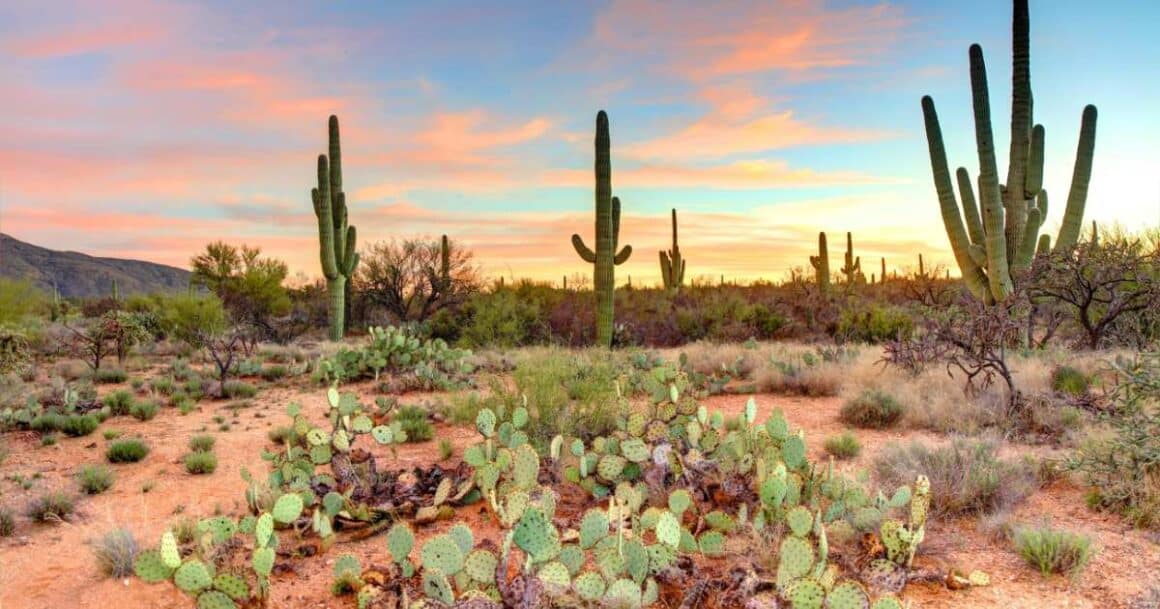
Understanding the Climate in Arizona
Arizona is known for its hot and dry climate, with temperatures often exceeding 100°F in summer, making it challenging to grow many types of plants.
To grow basil in Arizona, it’s essential to understand the state’s climate and how it can affect your plants.
It’s also important to note that Arizona’s climate can vary depending on where you live.
For example, areas in the northern part of the state are cooler and more humid, while areas in the southern region are hotter and drier.
Be sure to research the specific climate conditions in your area to determine the best strategies for growing basil.
Use this interactive USDA Hardiness Zone Map to learn about your planting zone!
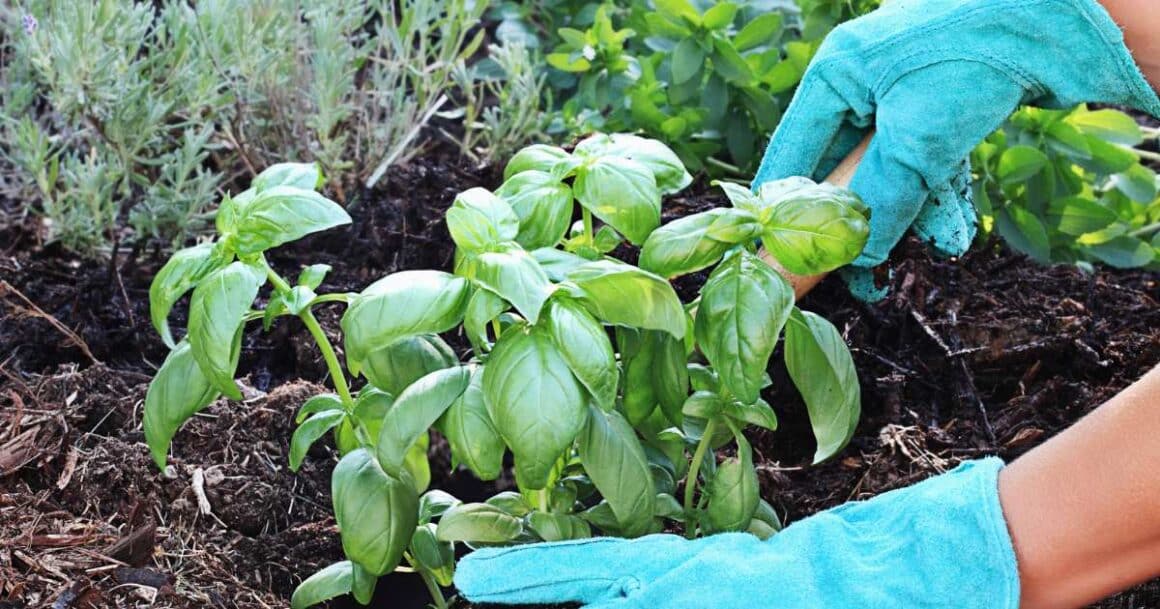
How to Grow Basil in Arizona:
Here are valuable tips and techniques on how to grow basil in Arizona, including the best time to plant, soil preparation, watering and fertilizing, pest and disease control, and how to harvest your basil!
The Best Time to Plant Basil in Arizona
Basil has a long growing season and can be grown year-round in Arizona (in some areas), but the best time to plant it depends on the specific climate conditions in your area.
The ideal time to plant basil in Arizona is early spring or fall when temperatures are milder. In the spring, you can start planting basil as soon as the danger of frost has passed.
This can be as early as February or March in some parts of Arizona.
Growing Basil in the Winter Months
If you want to grow basil year-round in winter, consider planting it indoors or in a greenhouse. This will allow you to control the temperature and moisture levels.
If you grow basil indoors, choose a location in your home that receives at least 6 hours of sunlight daily. A south-facing window is ideal, but you can also use a grow light if necessary.
1. Choose a Sunny Location.
Basil needs plenty of sunlight to grow and thrive. Choose a location in your garden that receives at least 6 hours of direct sun daily.
For best results, choose a location that provides afternoon shade during the hottest day to prevent the basil from wilting.
Rich, well-drained Soil:
Basil grows best in well-drained soil rich in organic matter. If soil is heavy or clay-like, amend it with compost or other organic matter to improve drainage and fertility.
2. Provide Rich Soil
The desert soil in Arizona can be pretty challenging for growing plants.
To grow basil in Arizona, it’s important to amend the soil with ample organic matter to improve its fertility and drainage.
Here are some tips for amending the soil to grow basil in Arizona:
Test Your Soil: Before amending your soil, it’s a good idea to determine its pH and nutrient levels. You can purchase a soil testing kit and test the soil yourself or send a sample to your local garden center for testing.
Add Compost: Compost is a great way to improve soil fertility and structure. Mix 2-3 inches of compost before planting your basil. If you don’t have access to compost, you can also use other organic materials, such as well-rotted manure or leaf mold.
Add Sand or Perlite: If your soil is heavy or clay-like, you can improve its drainage by mixing in some sand or perlite.
These materials will help break up the soil and improve its structure, helping it drain well.
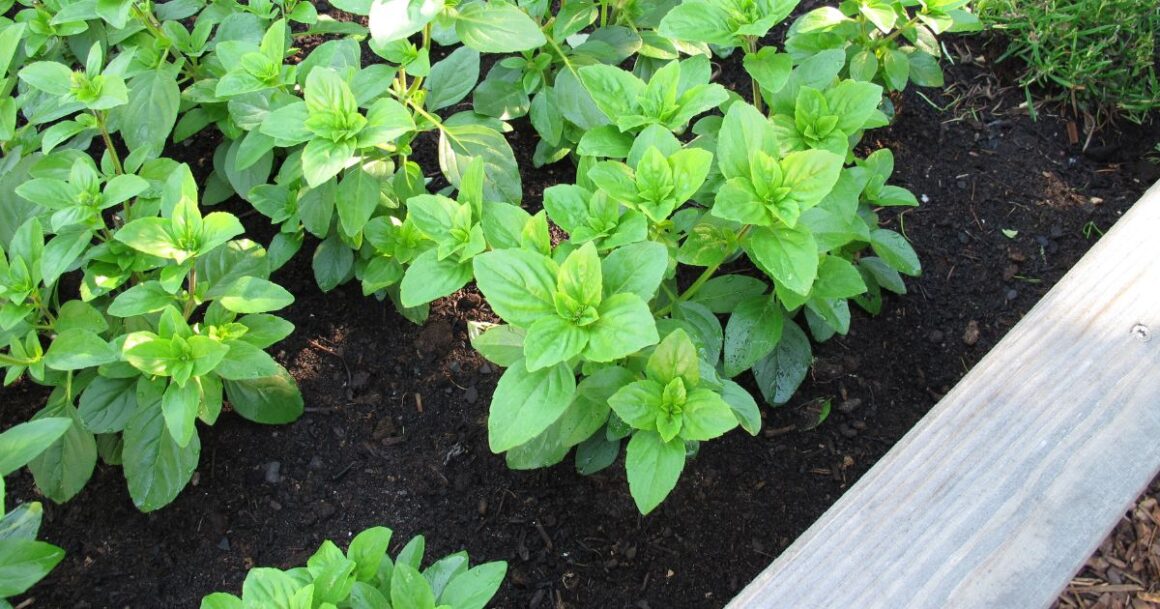
3. Grow Basil in Garden Beds or Large Containers.
Basil plants can grow significantly large if you are growing them for an entire season. Be sure to choose a location in your garden that provides enough space for your basil plants to grow and spread out.
Basil can also be grown in large pots or containers, making it an excellent option for gardeners with limited space. If you choose to plant basil in containers, you must ensure they have plenty of drainage holes.
Choose the Right Container, ensuring it is large enough to accommodate the plant’s roots and has plenty of drainage holes.
A container at least 12 inches in diameter and 12 inches deep is a good size for growing basil.
Soil is even more critical when planting basil in containers. Ensure the soil is formulated for container gardening, which allows the soil to drain correctly to avoid rot and disease.
Related article: How to Start a Raised Garden Bed Arizona Style!

Planting Basil: Seeds Vs Seedlings
There are two main options to planting basil: planting seeds or planting seedlings.
Both seeds and seedlings can be viable options for planting basil, and the best choice depends on your preferences and growing conditions.
Here are some pros and cons of each method:
Pros and Cons of Planting Basil Seeds
Pros of planting basil seeds:
- Cost-effective: Seeds are generally less expensive than seedlings.
- Wide variety: Seeds offer a more comprehensive array of basil varieties.
- Planting seeds gives you more control over the growing conditions from the start.
Cons of planting basil seeds:
- Longer time to harvest: Growing basil from seed takes longer to reach maturity and harvest than planting seedlings.
- Risk of failure: Seeds can be more challenging to grow and have a higher risk of failure than planting seedlings.
Pros and Cons of Planting Basil Seedlings
Pros of planting basil seedlings:
- Faster harvest: Planting seedlings allows you to harvest basil more quickly than planting seeds.
- Lower risk of failure: Seedlings have a higher chance of success than seeds since they are already partially grown.
- Convenience: Seedlings are easy to find at most garden centers and nurseries.
Cons of planting basil seedlings:
- More expensive: Seedlings are generally more costly than seeds.
- Limited variety: Seedlings may have a limited variety of basil types.
- Risk of transplant shock: Seedlings can experience shock when transplanted, slowing down their growth.
How to Plant Basil Seeds in Arizona
I have found planting basil seeds to be tricky! And to be honest, I prefer planting basil seedlings to sowing seeds. If you want to give seeds a try, here are some tips.
Tips for planting basil seeds in Arizona:
- Plant Time: Plant seeds either indoors or outdoors in the spring after the danger of frost has passed.
- Prepare the Soil: Prepare good quality soil as explained earlier 🙂
- Plant the Seeds: Sow basil seeds about 1/4 inch deep and 6-8 inches apart in rows. Be sure to plant them in a location with full sun or use a grow light if planting indoors.
- Water the Seeds: Keep the soil moist but not waterlogged. Basil seeds need regular watering to germinate and grow.
- Thin the Seedlings: Once the basil seedlings emerge, thin them out to allow enough space for each plant to grow. Thin them out to 12-18 inches apart.
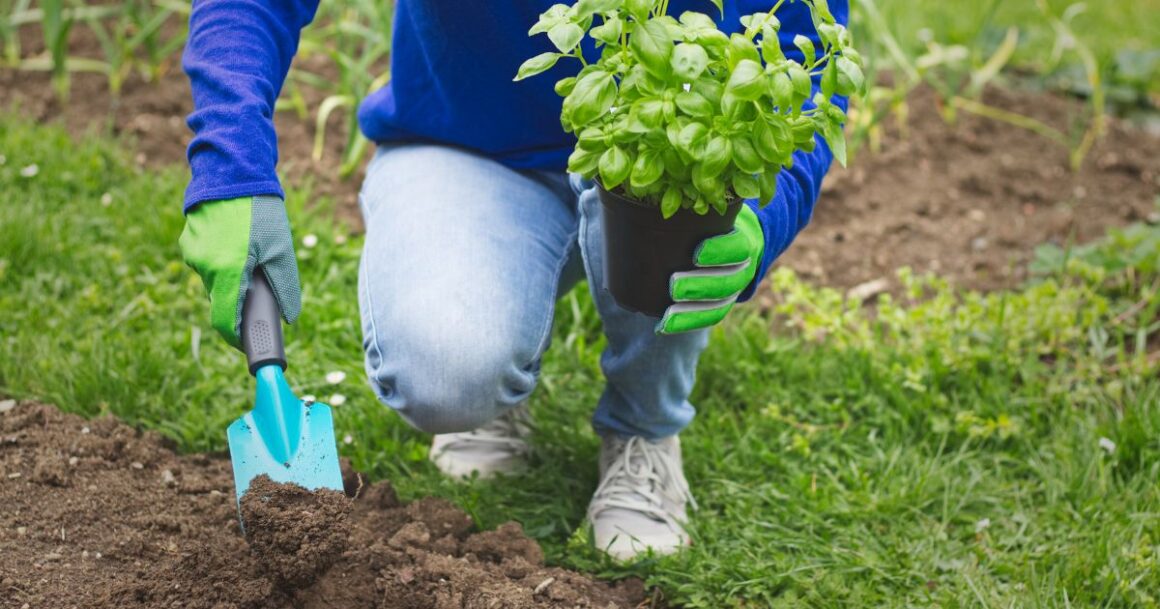
How to Plant Basil Seedlings in Arizona
Planting basil seedlings instead of basil seeds can be a great way to get a head start on the growing season. (this is my preferred method) 🙂
Tips for planting basil seedlings in Arizona:
- PlantingTime: Basil seedlings should be planted in the spring after the danger of frost has passed.
- Choose the Right Location: Choose a location in your garden that receives full sun and has rich, well-draining soil.
- Dig the Holes: Dig holes in the soil slightly larger than the root ball of your basil seedling.
- Plant the Seedlings: Gently remove the basil seedling from its container and place it in the hole, careful not to damage the roots.
Fill in the soil around the seedling and press it down lightly. - Water the Seedlings: Water the seedlings immediately after planting and then regularly thereafter. Basil seedlings need regular watering to establish themselves and grow.

4. Watering Tips for Basil Plants
Watering basil plants in Arizona can be a delicate balance between providing enough water for the plant to thrive and avoiding overwatering, which can lead to root rot.
Tips for watering basil plants in Arizona:
Water in the Morning: Water your basil plants in the morning when the temperatures are cooler, and the sun is not as intense. This will allow the water to soak into the soil before evaporating.
Water Deeply: When you water your basil plants, be sure to water deeply. This means giving the plant enough water to soak the soil to a depth of 6-8 inches. Shallow watering can lead to weak and shallow roots.
Avoid Overwatering: Overwatering can be a problem for basil plants. Be sure only to water your basil plants when the soil feels dry to the touch, and avoid watering them too frequently or letting them sit in overly moist soil.
Use a Drip Irrigation System: A drip irrigation system can effectively water your basil plants without overwatering them. This system delivers water directly to the plant’s roots, where it is needed most.
Mulch the Soil: the best way to retain moisture and prevent evaporation in the Arizona heat is to mulch the soil.
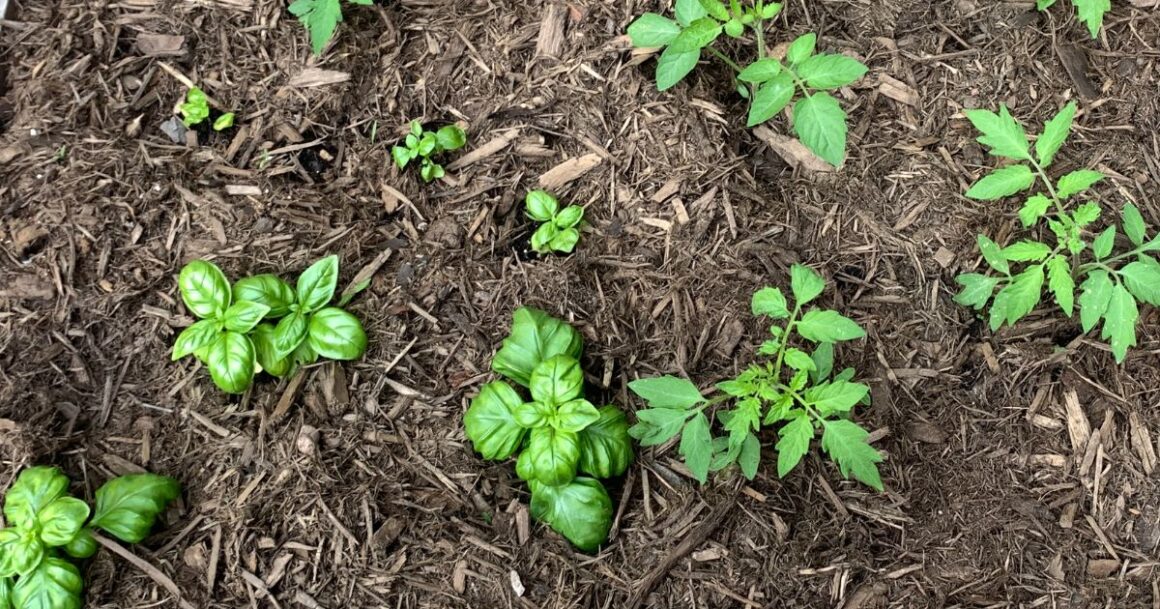
5. Mulching Tips When Growing Basil in Arizona
Mulching the soil around your basil plants can help retain moisture, regulate temperature, suppress weeds, and add nutrients.
Here are some steps for mulching the soil:
Clear the Area: Clear any debris or weeds from around the base of the basil plant, being careful not to damage the plant or its roots.
Apply the Mulch: Apply a layer of organic mulch around the base of the basil plant, being careful not to cover the stem or leaves. Good choices for mulch include straw, shredded leaves, grass clippings, or compost.
Water the Mulch: After applying the mulch, water the area around the basil plant to help settle the mulch and prevent it from blowing away.
Mulch maintenance: The mulch may break down or become compacted over time. Be sure to maintain the mulch by adding additional layers to keep it at 2-3 inches deep.
6. How to Fertilize Basil Plants in Arizona
Fertilizing basil plants in Arizona can be a key factor in promoting healthy growth and a bountiful harvest.
Tips for fertilizing basil plants in Arizona:
- Use Organic Fertilizer: Organic fertilizers are an excellent choice for basil plants because they are slow-release and provide more nutrients.
- Fertilize Regularly: Basil plants should be fertilized every two weeks during the growing season, from spring through early fall. Be sure to follow the instructions on the label carefully, as over-fertilizing can damage the plants.
- Apply Fertilizer in the Morning: Apply fertilizer in the morning when the temperatures are cooler, and the sun is not as intense. This will help prevent the fertilizer from burning the leaves of the plant.
- Water After Fertilizing: After applying fertilizer, thoroughly water your basil plants. This will help the nutrients soak into the soil and reach the plant’s roots.
- Avoid Fertilizing During Hot Weather: Avoid fertilizing your basil plants during hot weather, as this can stress the plants and make them more susceptible to damage.
- Adjust Fertilizer Levels Based on Plant Growth: As your basil plants grow, you may need to adjust the amount of fertilizer you use. Too much fertilizer can lead to excessive growth and weak stems, while too little fertilizer can stunt growth.
Related article: How to Make Homemade Fertilizers for Plants
7. Pruning Basil Plants in Arizona
Pruning basil plants is essential in promoting healthy growth and a bountiful harvest.
Tips for pruning basil plants:
- Pinch Off the Tops: Pinch off the top of the plant when it reaches a height of about 6 inches will encourage the plant to grow bushier and produce more leaves.
- Pinch-Off Flowers: When basil plants start to flower, they stop producing new leaves. To prevent this, pinch off the flowers as soon as you see them.
- Cut Back Leggy Stems: If your basil plant gets too long and leggy, you can cut back the stems to about 1/3 of their length. This will encourage new growth and a bushier plant.
- Prune Regularly: Regular pruning is essential for basil plants to prevent them from becoming too leggy and producing fewer leaves. Aim to prune your basil plants once a week during the growing season.
- Harvest Frequently: Harvesting your basil frequently will help promote bushy growth and prevent the plants from becoming too leggy. Pinch off individual leaves or cut entire stems just above a set of leaves, leaving enough leaves on the plant to continue growing.
- Use Sharp Pruning Shears: Use sharp pruning shears to avoid damaging the plant when pruning. Clean the shears between plants to prevent the spread of disease.
8. Dealing with Common Pests and Diseases
Like all plants, basil is susceptible to pests and diseases.
Some common pests affecting Arizona basil include aphids, spider mites, and whiteflies. Use insecticidal soap or neem oil spray to prevent and control these pests.
Be sure to follow the instructions on the label carefully.
Basil can also be affected by fungal diseases such as powdery and downy mildew.
To prevent these diseases, avoid overhead watering and keep the plants well-spaced to promote good air circulation. If you notice signs of disease, remove and destroy affected plant material to prevent it from spreading to other plants.
Related article: The Best Neem Oil for Plants

9. How to Harvest Basil in Arizona
Harvesting basil is easy and rewarding. Once your basil plants are about 6-8 inches tall, you can start to use your basil. Harvesting basil is an essential part of maintaining healthy and productive plants.
Here are some tips on how to harvest basil:
- Wait Until the Plant is Established: Wait until your basil plant is at least 6 inches tall and has several sets of leaves before harvesting. This will give the plant time to establish itself and produce more leaves.
- Harvest Mid-Morning: The best time to harvest basil is in the morning after the dew has evaporated. This will help ensure that the leaves are dry and free of moisture, which can reduce their shelf life.
- Pinch-Off Individual Leaves: Pinch off individual leaves from the plant, being sure to leave at least two sets of leaves on the stem. This will encourage the plant to produce more leaves and prevent it from becoming too leggy.
- Cut Entire Stems: If you need a larger quantity of basil, you can cut entire stems from the plant just above a set of leaves.
- Use the Basil Immediately or Store it Properly.

10. How to Store Basil in Arizona
Storing basil properly after harvest is essential to help preserve its flavor and prevent it from spoiling too quickly.
How to store basil after harvest:
Trim the Stems: Before storing basil, trim the stems by removing any lower leaves and making a fresh cut at the bottom of the stem. This will help the basil absorb water and stay fresh longer.
Rinse and Dry: Rinse the basil leaves in cool water to remove any dirt or debris, and then pat them dry with a clean towel or spin them in a salad spinner. Be sure to handle the leaves gently to avoid bruising or damaging them.
Choose a Storage Method:
Depending on how you plan to use it, there are several ways to store basil after harvest. Here are a few ways to keep fresh basil.
- Water Method: Place the trimmed basil stems in a jar or vase of water, as you would with cut flowers. Cover the basil leaves with a plastic bag and store them in the refrigerator. Change the water every couple of days to keep it fresh.
- Freezing Method: Place the basil leaves in a blender or food processor and pulse until finely chopped. Spoon the chopped basil into ice cube trays and freeze. Once frozen, transfer the cubes to a freezer bag and store in the freezer for up to 6 months.
- Drying Method: Tie the trimmed basil stems with twine and hang them upside down in a warm, dry place for 1-2 weeks. Once the leaves are dry and crumbly, remove them from the stems and store them in an airtight container.
FAQs: How to Grow Basil in Arizona
Do Basil Plants grow well in warmer climates like Arizona?
You bet! Basil plants are native to warm climates and grow well in warm temperatures. Basil plants thrive in hot and dry conditions, so they are commonly grown in regions with warm climates, such as the Mediterranean, Southeast Asia, and parts of Africa.
What is Arizona’s best time of year to grow basil?
Basil can be grown year-round in Arizona, but the best time to plant is in the spring or fall when temperatures are milder.
How often should I water my basil plants in Arizona?
Basil plants should be watered deeply but infrequently, allowing the soil to dry out slightly between waterings. This may mean watering every 2-3 days in hot and dry weather.
What are some common pests and diseases affecting Arizona basil?
Some common pests affecting Arizona basil include aphids, spider mites, and whiteflies. Common diseases include powdery mildew and downy mildew.
Can I freeze basil for later use?
Yes! You can freeze basil for later use. Simply wash and dry the leaves, chop them finely, and freeze them in ice cube trays filled with water.
Related Articles
Conclusion: How to Grow Basil in Arizona
Growing basil in Arizona can be a rewarding experience!
Whether planting from seed or seedlings, growing in the ground or containers, you can grow healthy and productive basil plants that will provide fresh herbs through the long growing season.
I hope this article helped you to understand how to grow basil in Arizona-If you have any further questions or tips to share, please leave a comment below.
Happy gardening!
XO, Christine

I’ve been keeping it real since 1963. 😊
I’m a child of God, devoted wife, proud mama and grandma, full-time creative, domestic engineer, and passionate self-care enthusiast.
I’m purpose-driven and do my best to live each day with intention—whether shopping for treasures, painting in my art studio, digging in the garden, or cooking up something yummy for my family.
I’m always up for a good chat and love collaborating with fellow creatives and brands.
Let’s connect—don’t be shy!
